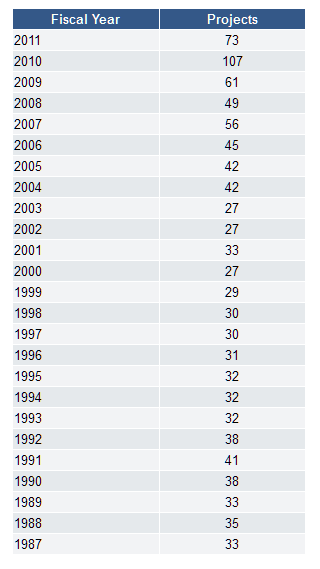Use NIH RePORTER to learn about grant-funded research at Northeastern
Did you know you can easily find out about research at Northeastern that’s being funded by the National Institutes of Health? The NIH RePORTER is “an electronic tool that allows users to search a repository of NIH-funded research projects and access publications and patents resulting from NIH funding.” It’s a component of NIH’s RePORT service (Research Portfolio Online Reporting Tools), and it “satisfies a legislative mandate included in the NIH Reform Act of 2006 to provide the public with an electronic system to search NIH research projects using a variety of codes, including public health area of interest, and provide information on publications and patents resulting from NIH-funded research.”
RePORTER shows that there are currently 96 active projects at Northeastern being funded by the NIH, from award years 2009 through 2011:
 Since 1987, Northeastern University researchers have worked on 1,023 NIH-funded projects:
Since 1987, Northeastern University researchers have worked on 1,023 NIH-funded projects:
 NIH RePORTER gives details of each funded project, including the award amount, the principal investigator(s), the project abstract and keywords, and any related projects or subprojects. It links each project to its published results in PubMedCentral as well as any related patents. As well as being able to search by institution, you can also search by investigator name, topic, geographic location, and specific funding agency, institute or center within NIH. If you create a free account you can receive weekly e-mailed alerts on your saved search queries (RSS is not yet available, but I hope it will be soon.) I highly recommend this resource for anyone who wants to learn more about health sciences research being conducted at Northeastern.
NIH RePORTER gives details of each funded project, including the award amount, the principal investigator(s), the project abstract and keywords, and any related projects or subprojects. It links each project to its published results in PubMedCentral as well as any related patents. As well as being able to search by institution, you can also search by investigator name, topic, geographic location, and specific funding agency, institute or center within NIH. If you create a free account you can receive weekly e-mailed alerts on your saved search queries (RSS is not yet available, but I hope it will be soon.) I highly recommend this resource for anyone who wants to learn more about health sciences research being conducted at Northeastern.
 Since 1987, Northeastern University researchers have worked on 1,023 NIH-funded projects:
Since 1987, Northeastern University researchers have worked on 1,023 NIH-funded projects:
 NIH RePORTER gives details of each funded project, including the award amount, the principal investigator(s), the project abstract and keywords, and any related projects or subprojects. It links each project to its published results in PubMedCentral as well as any related patents. As well as being able to search by institution, you can also search by investigator name, topic, geographic location, and specific funding agency, institute or center within NIH. If you create a free account you can receive weekly e-mailed alerts on your saved search queries (RSS is not yet available, but I hope it will be soon.) I highly recommend this resource for anyone who wants to learn more about health sciences research being conducted at Northeastern.
NIH RePORTER gives details of each funded project, including the award amount, the principal investigator(s), the project abstract and keywords, and any related projects or subprojects. It links each project to its published results in PubMedCentral as well as any related patents. As well as being able to search by institution, you can also search by investigator name, topic, geographic location, and specific funding agency, institute or center within NIH. If you create a free account you can receive weekly e-mailed alerts on your saved search queries (RSS is not yet available, but I hope it will be soon.) I highly recommend this resource for anyone who wants to learn more about health sciences research being conducted at Northeastern.